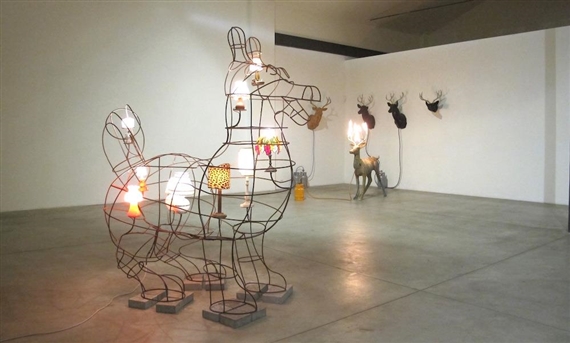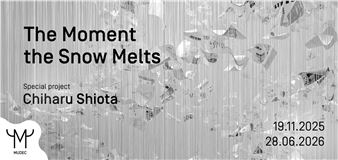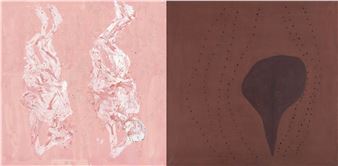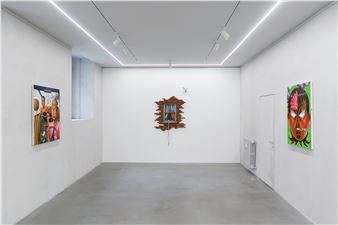Switch on 3
From February 24 to April 1, 2017, Galleria Fumagalli presents the group exhibition Switch On 3, with a selection of works by Vito Acconci, Giovanni Anselmo, Lawrence Carroll, Tony Cragg, Hanne Darboven, Giorgio Griffa, Jannis Kounellis, Chiara Lecca, Dennis Oppenheim, Gilberto Zorio.
The exhibition follows individual and complementary paths, which share a common conceptual approach, open to the displacement of thought. The creation of regulatory or sensitive systems that the artists involved have been implementing, leads the body to measure with the space and, more generally, with the universe and the place that the man occupy. тАЬSwitch OnтАЭ, literally тАЬturn on,тАЭ therefore refers to the principle of a movement (physical or conceptual) for new dimensions of interpretation and relation to reality.
Sculptor, performer and video artist, Vito Acconci is one of the major protagonists of body art and performance art. His photographic works, videos and performances focus on the body in the relationship with himself, the others and the architectural space. In тАЬFollowing PieceтАЭ, a daily activity made in October 1969, Vito Acconci follows a foreigner, chosen at random on the streets of New York, as long as this does not enter into a private space; by doing so, the artist тАЬis almost not anymore himself and gets to the scheme serviceтАЭ. Similarly, Dennis Oppenheim, who since the sixties experimented with the use of different media тАУ writing, action, video, cinema, photography, installation тАУ acts on the operation rather than the thing itself. Not limited to the mere creation of objects, Dennis Oppenheim develops an ambiguous and problematic system of signs that forces the viewer to question the absolute instability of the universe. It is the point of observation which is compromised in a constant metamorphosis rich in consequences.
In the same years Giovanni Anselmo joined the Arte Povera group engaging in a research aimed at enhancing the potential presence of the invisible in the visible, exposing the close relationship between the finite and infinite. Event detector in the poetics of Giovanni Anselmo is the dawn of August 16, 1965 when the artist, from the top of the volcano Stromboli, in a unique combination of time, space, sky and rising sun, discover to be deprived of his shadow. тАЬSenza titolo. Teoria dellтАЩOmbraтАЭ refers to the artistтАЩs research stimulated by the remembered experience lived on the volcano and the will to make manifest, in time and space, the forces in the making that the elements produce when in the encounter. Jannis Kounellis, also belonging to the Arte Povera, provides an infinte work of art starting a new process of consumption of an open work, able to involve the viewer. Thus the image becomes spatial interaction between the objects for the creation of a vision not far but encompassing the observer. Gilberto Zorio, another protagonist of the movement, followed a research for the communion between the rules of composition тАУ reset to an almost primal level of form and pure energy тАУ and the elements subjected to esoteric laws. From this emerges an art that leaves the caos to show its magical alchemical symbolic harmony.
Giorgio Griffa is one of the leading exponents of Analytical Painting, suggesting a mediated painting of signs and color, laid out with refined gestures that leave essential trace son the canvas. Rejecting the frame, the color becomes direct connection of the action and actual trace of thought, suggesting an idea of movement that through painting reaches the space that becomes finite, non-finite and infinite. The research of Lawrence Carroll also focuses on the experimentation of the various possibilities of being in the space, using painted frames containing objects (flowers, bulbs, shoes etc.), as volumes that interact with the environment. These assemblages create real bodies to be observed from different points of view, in a three-dimensional perspective. Tony Cragg instead goes in search of new relations between human beings and matter, without limiting the elements which he uses because there are no limits in the idea and form to achieve. тАЬSpillтАЭ, from 1988, shows the artistтАЩs interest in the theme of the dwelling, a symbol of the way in which humans change and is in relation with the environment.
Hanne DarbovenтАШs artistic research is a kind of тАЬmathematical literatureтАЭ in which handwritten progressions of values make manifest the passage of time in space. This is the case, for example, of the series тАЬThe Sundial / The MoonlightтАЭ in which each sheet refers to the first two months of the leap year 1976. The fact that one day more is added to the calendar to make the human time coincide with the natural one, becomes central for the artist in this work. Even for Chiara Lecca is fundamental the relationship between man and nature, her research in fact wants to show the fracture made by contemporary society and the contradiction in the removal of the most instinctive human and wild part for the benefit of the rational one.

Recommended for you
From February 24 to April 1, 2017, Galleria Fumagalli presents the group exhibition Switch On 3, with a selection of works by Vito Acconci, Giovanni Anselmo, Lawrence Carroll, Tony Cragg, Hanne Darboven, Giorgio Griffa, Jannis Kounellis, Chiara Lecca, Dennis Oppenheim, Gilberto Zorio.
The exhibition follows individual and complementary paths, which share a common conceptual approach, open to the displacement of thought. The creation of regulatory or sensitive systems that the artists involved have been implementing, leads the body to measure with the space and, more generally, with the universe and the place that the man occupy. тАЬSwitch OnтАЭ, literally тАЬturn on,тАЭ therefore refers to the principle of a movement (physical or conceptual) for new dimensions of interpretation and relation to reality.
Sculptor, performer and video artist, Vito Acconci is one of the major protagonists of body art and performance art. His photographic works, videos and performances focus on the body in the relationship with himself, the others and the architectural space. In тАЬFollowing PieceтАЭ, a daily activity made in October 1969, Vito Acconci follows a foreigner, chosen at random on the streets of New York, as long as this does not enter into a private space; by doing so, the artist тАЬis almost not anymore himself and gets to the scheme serviceтАЭ. Similarly, Dennis Oppenheim, who since the sixties experimented with the use of different media тАУ writing, action, video, cinema, photography, installation тАУ acts on the operation rather than the thing itself. Not limited to the mere creation of objects, Dennis Oppenheim develops an ambiguous and problematic system of signs that forces the viewer to question the absolute instability of the universe. It is the point of observation which is compromised in a constant metamorphosis rich in consequences.
In the same years Giovanni Anselmo joined the Arte Povera group engaging in a research aimed at enhancing the potential presence of the invisible in the visible, exposing the close relationship between the finite and infinite. Event detector in the poetics of Giovanni Anselmo is the dawn of August 16, 1965 when the artist, from the top of the volcano Stromboli, in a unique combination of time, space, sky and rising sun, discover to be deprived of his shadow. тАЬSenza titolo. Teoria dellтАЩOmbraтАЭ refers to the artistтАЩs research stimulated by the remembered experience lived on the volcano and the will to make manifest, in time and space, the forces in the making that the elements produce when in the encounter. Jannis Kounellis, also belonging to the Arte Povera, provides an infinte work of art starting a new process of consumption of an open work, able to involve the viewer. Thus the image becomes spatial interaction between the objects for the creation of a vision not far but encompassing the observer. Gilberto Zorio, another protagonist of the movement, followed a research for the communion between the rules of composition тАУ reset to an almost primal level of form and pure energy тАУ and the elements subjected to esoteric laws. From this emerges an art that leaves the caos to show its magical alchemical symbolic harmony.
Giorgio Griffa is one of the leading exponents of Analytical Painting, suggesting a mediated painting of signs and color, laid out with refined gestures that leave essential trace son the canvas. Rejecting the frame, the color becomes direct connection of the action and actual trace of thought, suggesting an idea of movement that through painting reaches the space that becomes finite, non-finite and infinite. The research of Lawrence Carroll also focuses on the experimentation of the various possibilities of being in the space, using painted frames containing objects (flowers, bulbs, shoes etc.), as volumes that interact with the environment. These assemblages create real bodies to be observed from different points of view, in a three-dimensional perspective. Tony Cragg instead goes in search of new relations between human beings and matter, without limiting the elements which he uses because there are no limits in the idea and form to achieve. тАЬSpillтАЭ, from 1988, shows the artistтАЩs interest in the theme of the dwelling, a symbol of the way in which humans change and is in relation with the environment.
Hanne DarbovenтАШs artistic research is a kind of тАЬmathematical literatureтАЭ in which handwritten progressions of values make manifest the passage of time in space. This is the case, for example, of the series тАЬThe Sundial / The MoonlightтАЭ in which each sheet refers to the first two months of the leap year 1976. The fact that one day more is added to the calendar to make the human time coincide with the natural one, becomes central for the artist in this work. Even for Chiara Lecca is fundamental the relationship between man and nature, her research in fact wants to show the fracture made by contemporary society and the contradiction in the removal of the most instinctive human and wild part for the benefit of the rational one.
Contact details


 ARTISTS
ARTISTS















